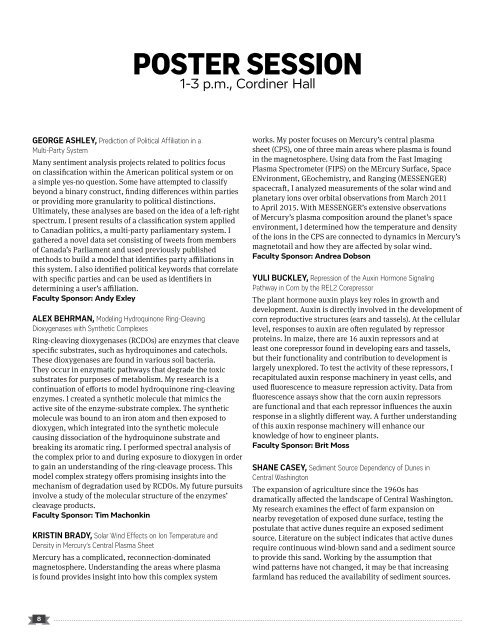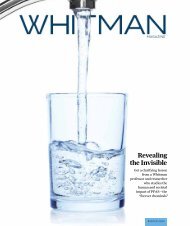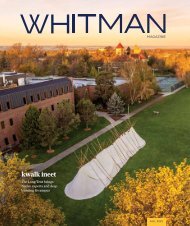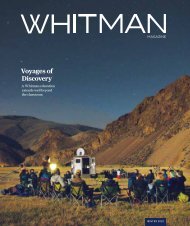Create successful ePaper yourself
Turn your PDF publications into a flip-book with our unique Google optimized e-Paper software.
POSTER SESSION<br />
1-3 p.m., Cordiner Hall<br />
GEORGE ASHLEY, Prediction of Political Affiliation in a<br />
Multi-Party System<br />
Many sentiment analysis projects related to politics focus<br />
on classification within the American political system or on<br />
a simple yes-no question. Some have attempted to classify<br />
beyond a binary construct, finding differences within parties<br />
or providing more granularity to political distinctions.<br />
Ultimately, these analyses are based on the idea of a left-right<br />
spectrum. I present results of a classification system applied<br />
to Canadian politics, a multi-party parliamentary system. I<br />
gathered a novel data set consisting of tweets from members<br />
of Canada’s Parliament and used previously published<br />
methods to build a model that identifies party affiliations in<br />
this system. I also identified political keywords that correlate<br />
with specific parties and can be used as identifiers in<br />
determining a user’s affiliation.<br />
Faculty Sponsor: Andy Exley<br />
ALEX BEHRMAN, Modeling Hydroquinone Ring-Cleaving<br />
Dioxygenases with Synthetic Complexes<br />
Ring-cleaving dioxygenases (RCDOs) are enzymes that cleave<br />
specific substrates, such as hydroquinones and catechols.<br />
These dioxygenases are found in various soil bacteria.<br />
They occur in enzymatic pathways that degrade the toxic<br />
substrates for purposes of metabolism. My research is a<br />
continuation of efforts to model hydroquinone ring-cleaving<br />
enzymes. I created a synthetic molecule that mimics the<br />
active site of the enzyme-substrate complex. The synthetic<br />
molecule was bound to an iron atom and then exposed to<br />
dioxygen, which integrated into the synthetic molecule<br />
causing dissociation of the hydroquinone substrate and<br />
breaking its aromatic ring. I performed spectral analysis of<br />
the complex prior to and during exposure to dioxygen in order<br />
to gain an understanding of the ring-cleavage process. This<br />
model complex strategy offers promising insights into the<br />
mechanism of degradation used by RCDOs. My future pursuits<br />
involve a study of the molecular structure of the enzymes’<br />
cleavage products.<br />
Faculty Sponsor: Tim Machonkin<br />
KRISTIN BRADY, Solar Wind Effects on Ion Temperature and<br />
Density in Mercury’s Central Plasma Sheet<br />
Mercury has a complicated, reconnection-dominated<br />
magnetosphere. Understanding the areas where plasma<br />
is found provides insight into how this complex system<br />
works. My poster focuses on Mercury’s central plasma<br />
sheet (CPS), one of three main areas where plasma is found<br />
in the magnetosphere. Using data from the Fast Imaging<br />
Plasma Spectrometer (FIPS) on the MErcury Surface, Space<br />
ENvironment, GEochemistry, and Ranging (MESSENGER)<br />
spacecraft, I analyzed measurements of the solar wind and<br />
planetary ions over orbital observations from March 2011<br />
to April 2015. With MESSENGER’s extensive observations<br />
of Mercury’s plasma composition around the planet’s space<br />
environment, I determined how the temperature and density<br />
of the ions in the CPS are connected to dynamics in Mercury’s<br />
magnetotail and how they are affected by solar wind.<br />
Faculty Sponsor: Andrea Dobson<br />
YULI BUCKLEY, Repression of the Auxin Hormone Signaling<br />
Pathway in Corn by the REL2 Corepressor<br />
The plant hormone auxin plays key roles in growth and<br />
development. Auxin is directly involved in the development of<br />
corn reproductive structures (ears and tassels). At the cellular<br />
level, responses to auxin are often regulated by repressor<br />
proteins. In maize, there are 16 auxin repressors and at<br />
least one corepressor found in developing ears and tassels,<br />
but their functionality and contribution to development is<br />
largely unexplored. To test the activity of these repressors, I<br />
recapitulated auxin response machinery in yeast cells, and<br />
used fluorescence to measure repression activity. Data from<br />
fluorescence assays show that the corn auxin repressors<br />
are functional and that each repressor influences the auxin<br />
response in a slightly different way. A further understanding<br />
of this auxin response machinery will enhance our<br />
knowledge of how to engineer plants.<br />
Faculty Sponsor: Brit Moss<br />
SHANE CASEY, Sediment Source Dependency of Dunes in<br />
Central Washington<br />
The expansion of agriculture since the 1960s has<br />
dramatically affected the landscape of Central Washington.<br />
My research examines the effect of farm expansion on<br />
nearby revegetation of exposed dune surface, testing the<br />
postulate that active dunes require an exposed sediment<br />
source. Literature on the subject indicates that active dunes<br />
require continuous wind-blown sand and a sediment source<br />
to provide this sand. Working by the assumption that<br />
wind patterns have not changed, it may be that increasing<br />
farmland has reduced the availability of sediment sources.<br />
8

















